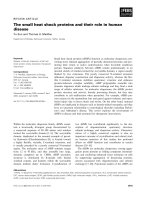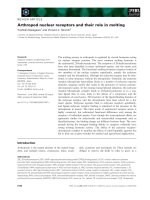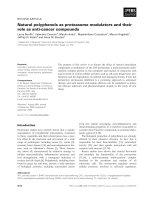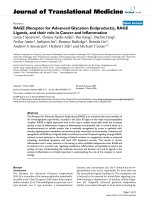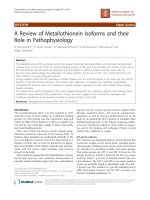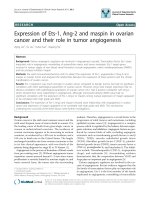Resistant Natural Enemies and their Role in IPM
Bạn đang xem bản rút gọn của tài liệu. Xem và tải ngay bản đầy đủ của tài liệu tại đây (324.77 KB, 7 trang )
Int.J.Curr.Microbiol.App.Sci (2020) 9(11): 3676-3693
International Journal of Current Microbiology and Applied Sciences
ISSN: 2319-7706 Volume 9 Number 11 (2020)
Journal homepage:
Review Article
/>
Insecticide Resistant Natural Enemies and their Role in IPM
Shahida Ibrahim*, Ramandeep Kour, Shalini Aryan and Nadeya Khaliq
Shere Kashmir University of Agricultural Sciences and Technology of Jammu, India
*Corresponding author
ABSTRACT
Keywords
Insecticide,
Integrated pest
management (IPM)
Article Info
Accepted:
24 October 2020
Available Online:
10 November 2020
Resistance is the genetic ability of some individuals in an arthropod pest population to survive an
application or multiple applications of a pesticide. In other words, the pesticide no longer effectively
kills a sufficient number of individuals in the arthropod pest population. Resistance develops at the
population level and is an inherited trait. As such, surviving arthropod pests can pass traits
genetically onto their offspring or next generation, enriching the gene pool with resistant genes
(alleles). The amount of ―selection pressure,‖ or the frequency of applying pesticides, is the main
factor that influences the ability of an arthropod pest population to develop resistance to pesticides.
This then increases the proportion or frequency of resistant individuals. Pesticide resistance in pests
has severe negative consequences but can be used as a positive trait for natural enemies as an
opportunity to improve the simultaneous use of two very valuable tools in pest management:
chemical and biological control. Biological control adoption is limited in some areas, crops, or
seasons due to the imperative use of pesticides needed to control diseases and pests. Most studies on
pesticides and natural enemies try to establish the degree of compatibility using only a population,
not considering the natural variation in insecticide susceptibility. However, there is variation in the
response to pesticides among populations of a beneficial species, similarly to the response in any
pest species. Knowledge of the natural and potential variation in the tolerance of natural enemies to
pesticides may improve the design of robust IPM strategies by extending the role of biological
control in some agricultural systems and by increasing the number of available compounds to control
diseases and key, secondary, and invasive pests. There are a number of excellent revisions on
pesticide resistance in natural enemies. In the present review, new cases of insecticide resistance in
natural enemies are discussed, as a better understanding of pesticide resistance in natural enemies
will allow us to enhance the integration of chemical and biological tools in IPM programs this time
period.
Introduction
Insect pest problems in agriculture have
shown a considerable shift during first decade
of twenty-first century due to ecosystem and
technological changes. In India, the crop
losses have declined from 23.3 per cent in
post-green revolution era to 17.5 per cent at
present (Dhaliwal et al., 2010). Biological
control has been accepted as an effective,
environmentally non-degrading, technically
appropriate, economically viable and socially
acceptable method of pest management. It
aims at suppression of insect pests of crops or
other harmful organisms by using their
natural enemies (parasites, predators and
pathogens). It constitutes a deliberate attempt
to use natural enemies, either by introducing
new species or by increasing the effectiveness
of the same those present already in the
3676
Int.J.Curr.Microbiol.App.Sci (2020) 9(11): 3676-3693
environment (Sankaran, 1986). In India the
earliest and successful introduction of a
natural enemy against an insect pest was the
coccinellid beetle Cryptolaemus montrouzieri
(Muls.) from Australia in 1898 (Rao et al.,
1971). Now a day, application of different
pesticides may depress populations of
beneficial insects as well as target pests.
Recent research has shown that pesticideresistant parasites selected in the laboratory
can be established in the field and enhance
IPM programs. Both laboratory selected or
genetically engineered natural enemies may
someday play an expanded role in IPM
programs and the reduction of pesticide use.
Genetic manipulation of natural enemies of
insect pests offers promise of enhancing their
efficacy in agricultural cropping systems.
Genetic improvement projects with natural
enemies of insects have been conducted for
Improved climatic tolerances
Improved host finding ability
Changes in host preference
Improved synchronization with the host
Insecticide resistance
Non-diapause
Induction of thelytokous reproduction
populations tend to rebound at a slower rate in
response to the lack of food, whereas insect
and mite pests recover quickly in the absence
of natural enemies. This is associated with a
low density of prey, which results in natural
enemies being negatively impacted in terms
of consumption rates, fecundity and survival.
Pre-adaptation hypothesis
The pre-adaptation hypothesis advances the
notion that herbivores or plant-feeding insects
and mites are already pre-adapted to detoxify
pesticides because they have evolved the
ability to detoxify plant defensive compounds
(e.g., secondary plant metabolites) such as
plant alkaloids. Because plant-feeding insects
and mites are typically exposed to a broad
diversity of plants and thus plant
allelochemicals (non-nutritional chemicals
synthesized by an organism that affect
growth, survival and behaviour of certain
member species), they are able to metabolize
a broad range of chemical defences by
producing inducible enzymes in response to
particular enzymes associated with specific
compounds.
Emerging technologies in augmentation of
natural enemies
However, there are sometimes inquires or
issues regarding why pesticide resistance is
rare or occurs less often in natural enemies
(e.g., parasitoids and predators) in comparison
to arthropod pests. There are two hypotheses
that may possibly explain this phenomenon:
1) the food limitation and 2) pre-adaptation
hypotheses.
Food limitation hypothesis
The food limitation hypothesis proposes that
natural enemies tend to not readily develop or
evolve
resistance
because
pesticide
applications, depending on frequency, reduce
their food supply by killing susceptible prey.
After applying pesticides, natural enemy
As in crop breeding, three potential genetic
manipulation tactics are being utilised for
achieving the above goals.
a. Artificial selection
b. Hybridization or, use of Heterosis
c. Use of Biotechnology (recombinant DNA
(rDNA)
techniques)
Artificial selection
Artificial selection of arthropod natural
enemies for resistance to pesticides has been
proposed as a method form improving the
usefulness of natural enemies in integrated
3677
Int.J.Curr.Microbiol.App.Sci (2020) 9(11): 3676-3693
pest management programs (Roush and Hoy,
1981; Hoy, 1985).
How does a resistant population come into
existence
(IRAC database, 2010)
Pesticide resistance is a genetically based
phenomenon. Resistance occurs when an
insect population— insects, for instance— is
exposed to a pesticide. When this happens,
not all insects are killed. Those individuals
that survive frequently have done so because
they are genetically predisposed to be
resistant to the pesticide. Repeated
applications and higher rates of the insecticide
will kill increasing numbers of individuals,
but some resistant insects will survive. The
offspring of these survivors will carry the
genetic makeup of their parents. These
offspring, many of which will inherit the
ability to survive the exposure to the
insecticide, will become a greater proportion
with each succeeding generation of the
population. Because of the rapid reproductive
rate of many insects — a generation of many
insects can take place in a few weeks — many
generations can be produced in a single
season or year. It‘s easy to see that repeated
applications of an insecticide will quickly
eliminate all susceptible insects in the
population, essentially selecting out those
individuals that are resistant. In a short period
the entire population of insects will be
resistant. The more times a population is
exposed to a pesticide, especially a broadspectrum pesticide, the more quickly
resistance will develop.
This study was conducted in PDBC (Project
Directorate of Biological Control) Bangalore
by Jalali and his coworkers in 2005 in
Trichogramma chilonis against Endosulfan.
The doses were increased during each
successive generation of selection. The
selection was initiated at a dose of 0.004%
which was gradually increased to 0.009 %. At
lowest concentration the survival among
tolerant strain 95% and parasitism is 100% as
compared to susceptible strains having per
cent survival only 10% and parasitism 40%.
At lower concentration parasitoids took ≤ 1012 generations to develop resistance while at
higher concentrations took 24-90 generations
to develop resistance. In the susceptible
population over 90% mortality and 10%
parasitism was obtained at each concentration
as compared to resistant strain of parasitoid
(40% mortality and 90% parasitism) after
each successive generation of exposure to
insecticide.
From LC50 value it is concluded that the
resistant factor of tolerant strain was 15.1
folds and F1 cross were 8.53 folds over
susceptible strain
An endosulfan tolerant strain of T. chilonis
was developed and transferred to a private
industry, which is marketing it under the
name of ‗Endogram‘.
This experiment was conducted by Elizabeth
E. Grafton-Cardwell and Marjorie A. Hoy in
California during the year 1981 -1982. They
collected adult C. carnea from alfalfa in San
Joaquin, Fresno, Kern, and Imperial counties
during 1981 and 1982 and maintained them as
four separate colonies. Adults, larvae, and
eggs
were
screened
with
the
organophosphates diazinon (50 percent WP)
and phosmet (Imidan, 50 percent WP), the
carbamates carbaryl (Sevin, 50 percent WP)
and methomyl (Lannate, WS liquid), and the
pyrethroids permethrin (Ambush, Pounce,
3678
Int.J.Curr.Microbiol.App.Sci (2020) 9(11): 3676-3693
EC) and fenvalerate (Pydrin, EC). Adults
were tested in petri dishes sprayed with a
range of concentrations of formulated
pesticide in water plus a wetting agent. Each
dish containing five adult lacewings was
closed with tissue paper, and adults were
provided with food and water. Twenty adults
were tested at each concentration, and
mortality was assessed after 72 hours.
Selection for carbaryl resistance occurred
very rapidly in this assay (Fig. 1). All San
Joaquin County larvae died at rates above
0.003 pound active ingredient per 10 gallons.
Of the unselected Imperial County larvae, 97
to 99 percent died at rates above 0.03 pound,
but after only one selection (carbaryl-1),
mortality decreased to approximately 90
percent at these rates. Mortality decreased to
50 to 70 percent after the second round of
selection (carbaryl-2) and to less than 20
percent after four rounds of selection. Up to
80 percent of the selected lacewing larvae
survived on formulated material at the field
rate recommended for alfalfa (approximately
1.5 pounds active ingredient per 10 gallons),
compared with only 3 percent of the
unselected strain.
Hybridization
Different local strains from various agroclimatic regions were collected and interbreeding was carried.
Hybridization results in heterosis
heterobeltiosis in the offsprings.
and
Patil and Yadav (1999) studied estimates of
heterosis and heterobeltiosis for some
important traits of hybrids of Corcyra carnea.
This experiment was conducted by Hidesh
Naka and co-workers in Japan. Chrysoperla
carnea was introduced from Germany and
Chrysoperla nipponensis was indigenous
from Japan. Adult C. nipponensis were
collected from NIAES (Tsukuba, Japan)
fields. C. carnea larvae (Kagetaro) were
purchased from Arysta LifeScience (Tokyo,
Japan). The two species were reared in a
similar manner. Approximately 50 females
and 50 males were maintained in a 30 by 30
by 30-cm cage, supplied with water and a
honey-yeast diet (a mixture of water, honey,
and yeast extract as 10:10:3 mass ratio,
respectively) and applied to absorbent cotton
according to a modified version of the method
of Henry (1979). Larvae were individually
reared by supplying _20 mg of Entofood
(frozen eggs of Ephestia kuehniella; Arysta
Life- Science) every 2 d. Rearing and
experiments were conducted under conditions
of 16 L:8 D at 25oC. Crosses were carried out
with one pair of 7-14 days old virgin adults,
kept in a plastic cup (75 mm diameter by
45mmheight, 100 ml), supplied with water
and a honey-yeast diet. There were 30
replicates each of parental conspecific
crosses, C. carnea ×C. Carnea and C.
nipponensis × C. nipponensis, and 63
replicates of interspecific crosses, C. Carnea
females × C. Nipponensis males and C.
nipponensis females ×C. Carnea males.
Interspecific offspring (F1) were reared
individually and supplied with Entofood, and
emerged adults were crossed with each other
or backcrossed to their parent species.
The designed F1 cross experiment to obtain
an equal and maximal number of replicates
using emerged F1 adults; consequently, we
could ensure that all crosses of F1 adults were
replicated by five pairs. Reproductive
potential, fertility rate or the number of
offspring, seeds or spores per ―parent‖, has a
significant effect on the development of
resistance in insect populations. For all
sexually reproductive insects that are targeted
by pesticides, and with other factors being
equal, the greater the number of offspring per
organism, the larger the number of resistant
individuals there will be.
3679
Int.J.Curr.Microbiol.App.Sci (2020) 9(11): 3676-3693
The reason for this in insects is that producing
a large number of offspring increases the
chances of there being more individuals
carrying the resistance gene and hence, if
pesticide use continues, the odds of selecting
individuals that carry one or two resistant
alleles. The larger the number of survivors
carrying resistance genes, the greater the
potential is for heterozygote or homozygote
individuals to mate. This can result in an
increase in the frequency of the resistance
genes in the population. The cross between
c×n shows higher fertility percentage (90%)
(Table 1–6).
fundamental goal of laboratory geneticists is
to isolate, characterize, and manipulate genes.
Although it is relatively easy to isolate a
sample of DNA from a collection of cells,
finding a specific gene within this DNA
sample can be compared to finding a needle
in a haystack.
Recombinant DNA techniques
The goal of genetic improvement can be
achieved rapidly, without the generations of
rearing required for classical selection
protocols
Recombinant DNA technology, joining
together of DNA molecules from two
different species that are inserted into a host
organism
to
produce
new
genetic
combinations that are of value to science,
medicine, agriculture, and industry.
Since the focus of all genetics is the gene, the
Advantages of biotechnological approaches
over artificial selection
The use of genetic engineering methods for
the improvement of beneficial arthropods has
two advantages over artificial selection:
Rather than selecting solely from the
available gene pool of the arthropod natural
enemy, any gene from any species can be
used, in principle, for genetic improvement
Processes of developing genetically modified natural enemy
What is involved in recombination DNA
techniques……….?
It involves various steps
Knowledge of biology, ecology
behaviour of target species
Identifying traits to be altered
3680
and
Int.J.Curr.Microbiol.App.Sci (2020) 9(11): 3676-3693
Suitable gene must be identified, cloned and
insert into insect genome.
What germ-line transformation methods
are available………?
Inserting cloned DNA into insect can be
accomplished by:
Transposable element vectors
Paratransgenesis
Viral vectors
Transposable element vectors
A transposable element (TE or transposon) is
a DNA sequence that can change its position
within a genome, sometimes creating or
reversing mutations and altering the cell's
genetic
identity
and
genome
size.
Transposition often results in duplication of
the TE. Barbara McClintock's discovery of
these jumping genes earned her a Nobel Prize
in 1983. Transposable elements are used as
vectors for the transfer of foreign DNA into
host. While all the transformation vectors
Paratransgenesis
Genetic alteration of microbes living in
association with insects for various purposes
The symbionts are passed through generations
currently used for non-drosophilid germ-line
transformation are Class II transposable
elements that share common elements in
terms of structure and mechanism of
movement, significant differences exist
among them and thus they must be considered
independently when assessing risk.
A primary consideration is that these
transposons, along with other mobile genetic
elements, are mutagenic by virtue of their
ability to integrate into coding and noncoding genomic DNA sequences. Thus, they
have the potential to disrupt normal gene
function resulting in costs to fitness. On the
other hand, a large percentage of most
genomes are comprised of such mobile
elements, and various mechanisms either have
pre-existed or have evolved to regulate
transposon function. A major concern relates
to how a genome interacts with a transposonbased vector that has been newly introduced.
Each of the currently available Class II
transposon-based vector systems are reviewed
below and some of their key characteristics
are highlighted.
by transovariole transfer
The two bacterial endosymbionts Wolbachia
sp. (Gram negative)and Rhodococcus sp.
(Gram positive) are commonly employed
3681
Int.J.Curr.Microbiol.App.Sci (2020) 9(11): 3676-3693
Viral vectors
Viruses are modified to as vectors in insects
and insect cell (Burns, 2000)
Baculovirus vectors
Densonucleosis virus vector
Polydna viral vector
Retroviral vector
causes inactivation of the polyhedron gene, cells
carrying the recombinant baculovirus will be
occlusion negative, visually distinguishable
from cells containing occlusion positive wildtype virus.
The frequency of recombination by this
technique is less than 1%, and occlusionnegative plaques are frequently obscured among
the high background of wild-type (occlusionpositive) plaques.
Baculovirus vectors
Baculovirus expression systems have found
increasing applications for the production of
eukaryotic biologically active proteins. The
system is similar to mammalian cells, in that
it exhibits posttranslational processing folding, disulfide formation, glycosylation,
phosphorylation, and signal peptide cleavage.
The system utilizes the baculovirus,
Autographa californica multiple nuclear
polyhedrosis virus (AcMNPV), which infects
many species of Lepidoteran insects. The
insect cells used in most laboratory
experiments are derived from cultured ovarian
cells of Spodopterafrugiperda (Fig. 2 and 3).
Baculovirus Transfer Vector
In practice, AcMNPV genome is too large
(128 kb) to work with. A baculovirus transfer
vector has to be constructed for cloning use.
Transfer vectors contain: (1) a ~7 kb fragment
of AcMNPV carrying the polyphedrin gene,
and (2) a multiple cloning site constructed
downstream of the polyhedrin gene promoter
The gene of interest is to be inserted in the
MCS. Both the recombinant transfer vector
DNA and wild-type viral DNA are used to
transfect insect cells. Within the cell, the
inserted gene sequence is transferred to the
AcMNPV viral DNA by homologous
recombination forming the recombinant
baculovirus DNA.
Since insertion of a foreign gene at the MCS
downstream of the polyhedrin gene promoter
Retroviral vector
Retroviruses are RNA viruses that replicate
via a ds-DNA intermediate. The infection
cycle begins with the interaction between
viral envelope and the host cell‘s plasma
membrane, delivering the particle into the
cell. The capsid contains two copies of the
RNA genome, as well as reverse
transcriptase/integrase.
After infection, the RNA genome is reverse
transcribed to produce a cDNA copy, a DNA
intermediate, which integrates into the
genome randomly. Retroviruses contain RNA
as the genetic material in a protein core
enclosed by an outer envelop.
The viral RNA genome contains at the 5' and
3' ends, long terminal repeats (LTR) carrying
the transcriptional initiation and termination,
respectively. In between the 5' and 3' LTR
regions, are three coding regions for viral
proteins (gag for viral core proteins, pol for
the enzyme reverse transcriptase, and env for
the envelop), and a psi (\|/) region carrying
signals for directing the assembly of RNA in
forming virus particles.
Retrovirus Vector and Packaging Cell
Retroviruses cannot be used directly as
vectors because they are infectious. Safe
retrovirus vectors are constructed using a
system consisting of two components: (1)
3682
